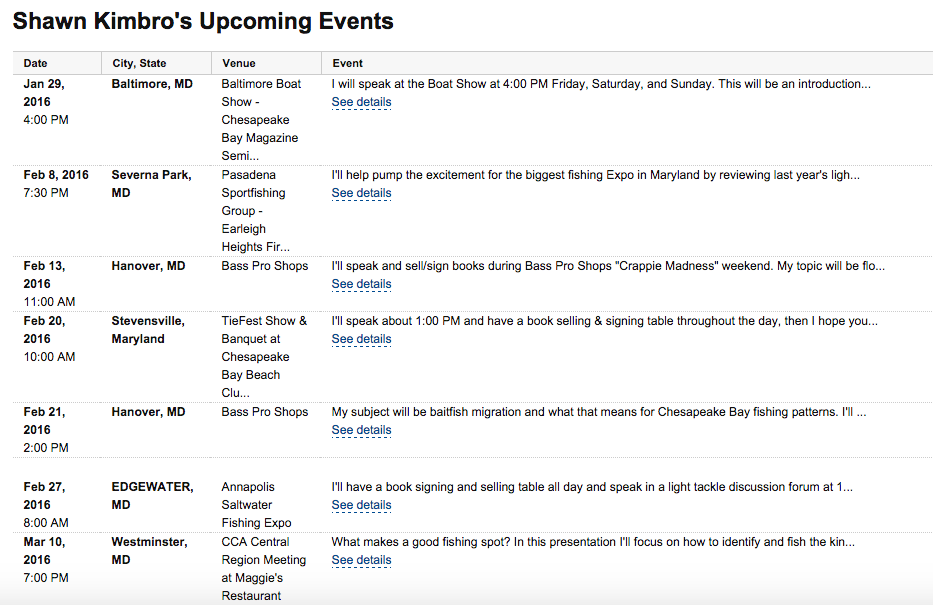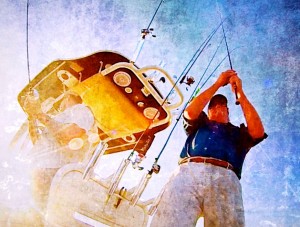jigging
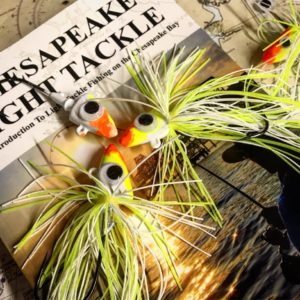 Have you noticed all the creativity in lure making for Chesapeake Bay rockfish lately? The artistry that is going into decorating the lead jig heads that we use while fishing with light tackle is simply amazing. I’m a big fan of the lures these guys and girls are turning out. I was going through some old papers last week when I happened upon the documents I used in 2008 to file for a trademark on the name “Candy Corn Jigs.” It wasn’t a big deal. My thinking was that someday I might want to make and sell lures and it seemed like a cool name for my favorite combination of colors for catching rockfish. That got me thinking about the history of color-contrasting lures and how far we’ve come in the last ten years. In fishing, as with many things, you can get a better understanding of where we’re going when you look back at where we’ve been. Believe it or not, in 2009 you could get a pretty good argument about whether rockfish jigs should even be painted. One light tackle guide from Southern Maryland was fond of saying, “When people ask me what my favorite color is for jig heads, I say lead.” If jigs were painted at all, they were usually only one single color: either red, chartreuse, or white. Fast forward to almost 2018, and we’re seeing all manner of colors and color combinations on the jig heads we use to catch rockfish with light tackle on the Bay. I think we’re all better anglers for it. Read More!
Have you noticed all the creativity in lure making for Chesapeake Bay rockfish lately? The artistry that is going into decorating the lead jig heads that we use while fishing with light tackle is simply amazing. I’m a big fan of the lures these guys and girls are turning out. I was going through some old papers last week when I happened upon the documents I used in 2008 to file for a trademark on the name “Candy Corn Jigs.” It wasn’t a big deal. My thinking was that someday I might want to make and sell lures and it seemed like a cool name for my favorite combination of colors for catching rockfish. That got me thinking about the history of color-contrasting lures and how far we’ve come in the last ten years. In fishing, as with many things, you can get a better understanding of where we’re going when you look back at where we’ve been. Believe it or not, in 2009 you could get a pretty good argument about whether rockfish jigs should even be painted. One light tackle guide from Southern Maryland was fond of saying, “When people ask me what my favorite color is for jig heads, I say lead.” If jigs were painted at all, they were usually only one single color: either red, chartreuse, or white. Fast forward to almost 2018, and we’re seeing all manner of colors and color combinations on the jig heads we use to catch rockfish with light tackle on the Bay. I think we’re all better anglers for it. Read More!
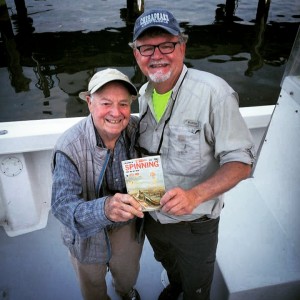 A lot has been written about the art in fly fishing. There is grace and beauty in a perfect fly cast. What is more satisfying than watching a colorful trout rise from a crystal clear pool to take a hand-tied floating fly? I just returned from Colorado where I had ample time to fly fish in the cold streams of the Gunnison National Forest. I don’t get to fly fish for trout much, but when I do, I’m always struck by the similarities to light tackle casting for rockfish on the Chesapeake Bay. One of the most important aspects of fly fishing is the ability to read the water and cast to where the fish are. Another is presenting the lure naturally so that it moves at the exact same speed as the current. While we don’t hear about it as much, there is comparable art in light tackle casting, even when it’s done with a spinning outfit or a baitcaster.
A lot has been written about the art in fly fishing. There is grace and beauty in a perfect fly cast. What is more satisfying than watching a colorful trout rise from a crystal clear pool to take a hand-tied floating fly? I just returned from Colorado where I had ample time to fly fish in the cold streams of the Gunnison National Forest. I don’t get to fly fish for trout much, but when I do, I’m always struck by the similarities to light tackle casting for rockfish on the Chesapeake Bay. One of the most important aspects of fly fishing is the ability to read the water and cast to where the fish are. Another is presenting the lure naturally so that it moves at the exact same speed as the current. While we don’t hear about it as much, there is comparable art in light tackle casting, even when it’s done with a spinning outfit or a baitcaster.
In my years of fishing both fresh and saltwater, I’ve had opportunities to observe the skills and artistry of some of the finest anglers in the world. As a teenager, I guided some of the best-known bass pros in the country when they practiced for tournaments in my home lakes in Tennessee. I’ve been fortunate enough to wade the pristine streams of the Smoky Mountains with the most knowledgeable anglers in the business, and I’ve fished for bonefish and pompano with the legendary guide families of the Bahamas. Most recently, I was joined on my boat Thunder Road by one of the best-known anglers in the world: the legendary Lefty Kreh. Lefty has been fishing for almost a half century longer than I’ve been alive. He’s forgotten more in his 92 years than I can ever hope to learn.
We caught all the fish we wanted that day, and enjoyed several hours of inspiring conversation. Lefty’s fly casting skills are legendary, but his prowess with a spinning outfit is less well-known. Between hooksets, we talked about casting and jigging techniques as well as patterns and the best ways to approach fishing spots. At one point, the conversation turned to the art in fishing. I’m happy to say that after listening to Lefty’s jokes, advice, and aphorisms refined over his long life of fishing, I came away a better fisherman and, hopefully, a better person.
Here are some of the thoughts I’ve collected about the art in light tackle casting: Read More!
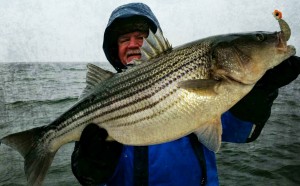 Jamie Clough, Rich Jenkins, and I joined Phil Kirchner for a run south out of Hoopersville recently. The weather hasn’t been great lately, but we’ve been catching some nice fish down around the mouth of the Potomac River. The forecast of light winds and snow flurries had us looking forward to a nice smooth ride and the opportunity to find lots of fish. Neither of those things happened! Instead, the Delmarva Pennisula and Southern Maryland were hit with one to three inches of snow and twenty-mile-an-hour winds gusting to thirty. Let’s just say the ride back was a little wet and sporty. Click the photo for the video and you’ll see what I mean.
Jamie Clough, Rich Jenkins, and I joined Phil Kirchner for a run south out of Hoopersville recently. The weather hasn’t been great lately, but we’ve been catching some nice fish down around the mouth of the Potomac River. The forecast of light winds and snow flurries had us looking forward to a nice smooth ride and the opportunity to find lots of fish. Neither of those things happened! Instead, the Delmarva Pennisula and Southern Maryland were hit with one to three inches of snow and twenty-mile-an-hour winds gusting to thirty. Let’s just say the ride back was a little wet and sporty. Click the photo for the video and you’ll see what I mean.
 Below is my speaking schedule for the next few months. We were happy to see one of the biggest audiences ever for my talk last weekend at the Frederick Fishing Expo. There are several more coming up so I hope you can make it. Most of my talks this winter will summarize my top-ten tips for trophy striper fishing. I’ll also break down float-and-fly crappie fishing at the Bass Pro Shops talk and the following weekend I’ll explain bait migrations in the Chesapeake and what that means for light tackle anglers. Also, I’m stoked to be on the same speaking schedule as Lefty Kreh and Bob Popovics at this years Fly & Light Tackle Fest. This year it’s at the Chesapeake Bay Beach Club just beneath the Bay Bridge on Kent Island. There’s more information about these fun events on my Amazon Author’s Page and I’ll keep you posted here and on Facebook and Twitter. I hope to see you at any or all or better yet, out there on the water!
Below is my speaking schedule for the next few months. We were happy to see one of the biggest audiences ever for my talk last weekend at the Frederick Fishing Expo. There are several more coming up so I hope you can make it. Most of my talks this winter will summarize my top-ten tips for trophy striper fishing. I’ll also break down float-and-fly crappie fishing at the Bass Pro Shops talk and the following weekend I’ll explain bait migrations in the Chesapeake and what that means for light tackle anglers. Also, I’m stoked to be on the same speaking schedule as Lefty Kreh and Bob Popovics at this years Fly & Light Tackle Fest. This year it’s at the Chesapeake Bay Beach Club just beneath the Bay Bridge on Kent Island. There’s more information about these fun events on my Amazon Author’s Page and I’ll keep you posted here and on Facebook and Twitter. I hope to see you at any or all or better yet, out there on the water!
“Swish!”
“What’s that sound?” I kept fishing, pretending not to notice the conversation in the back of the boat. Hank DiNardo had been nice enough to invite me out on his Southport 28TE to fish Eastern Bay. I hadn’t fished with Hank before and he wasn’t familiar with my quick-snap style of jigging. The fish finder told us there was fish around the boat, but they weren’t biting. I was up on the bow using every strike trigger I knew, including snapping my jig for all I was worth.
From the back I heard my regular fishing partner, Jamie Clough explaining, “That’s just the way Kimbro jigs sometimes.”
Indeed. That was seven years ago and since then I’ve earned something of a reputation for my energetic, somewhat spastic jigging style. When fishing is tough, you’ll frequently hear my rod tip cutting through the air as I snap my soft plastic jigs off the bottom. It’s a technique that’s been both mocked and revered with the biggest detractors being a couple of local guys who thought they already had it all figured out and the strongest proponents being newcomers to the Chesapeake Bay light tackle game who just want to catch more fish.
Why snap jigging? Read More!
My year in review video:
Most of the anglers I know caught rockfish last year. Some of us here in Maryland had a pretty good year. One of the reasons we caught well in 2014 is because we had a lot of fish very close to home. I don’t like to kick off a new year on a down note, but I’m not too excited about our catching last year. Our area is one of the few places in the country where striped bass fishing was decent in 2014. Did we have a good year, or have we lowered our expectations? Read More!
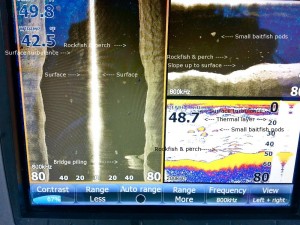 We interrupt this conservation blog with a fishing report. Nah, it’s the other way around. Chesapeake Light Tackle will always be first and foremost a fishing-report website. Well, fishing reports along with some occasional good advice about gear and techniques. Don’t worry – I won’t be lightening up on Maryland DNR’s bad decision to increase rockfish harvest by 14 percent in the face of impending cuts, but I wanted to let you know that I have been lighting up some local fishing spots lately. It’s the holidays, and the weather hasn’t been great, but there are still some fish to be caught for those who are willing to brave the elements and cast for them. The warm water discharges have been hit-and-miss lately. Most of the anglers who have visited them have been disappointed, but once in a while, I hear of a good fish or two being caught. The same goes for the deep holes at the mouths of the rivers and also for my go-to-winter honey hole: Light Tackle University (“LTU”). Read More!
We interrupt this conservation blog with a fishing report. Nah, it’s the other way around. Chesapeake Light Tackle will always be first and foremost a fishing-report website. Well, fishing reports along with some occasional good advice about gear and techniques. Don’t worry – I won’t be lightening up on Maryland DNR’s bad decision to increase rockfish harvest by 14 percent in the face of impending cuts, but I wanted to let you know that I have been lighting up some local fishing spots lately. It’s the holidays, and the weather hasn’t been great, but there are still some fish to be caught for those who are willing to brave the elements and cast for them. The warm water discharges have been hit-and-miss lately. Most of the anglers who have visited them have been disappointed, but once in a while, I hear of a good fish or two being caught. The same goes for the deep holes at the mouths of the rivers and also for my go-to-winter honey hole: Light Tackle University (“LTU”). Read More!



